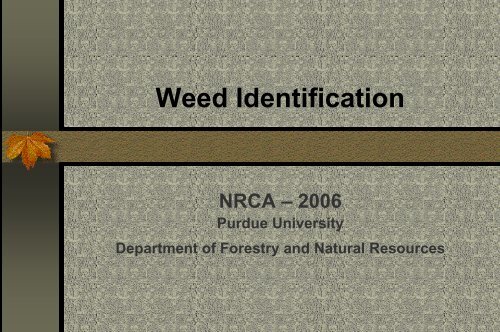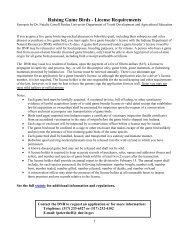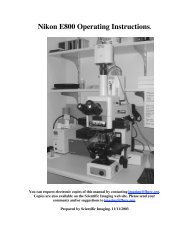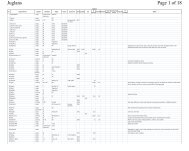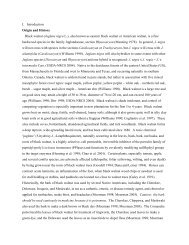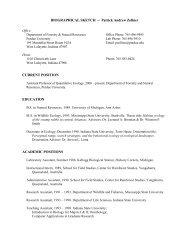Weed Identification for NRCA - Purdue Agriculture - Purdue University
Weed Identification for NRCA - Purdue Agriculture - Purdue University
Weed Identification for NRCA - Purdue Agriculture - Purdue University
Create successful ePaper yourself
Turn your PDF publications into a flip-book with our unique Google optimized e-Paper software.
<strong>Weed</strong> <strong>Identification</strong><br />
<strong>NRCA</strong> – 2006<br />
<strong>Purdue</strong> <strong>University</strong><br />
Department of Forestry and Natural Resources
Plant Characteristics<br />
Woody plants<br />
Trees-perennial, single main stem or trunk<br />
Shrubs-perennial, more than one principal<br />
stem, shorter than trees
Plant Characteristics<br />
Broadleaf Forbs or Herbaceous Plants<br />
Non-woody stems that die/dieback each<br />
year<br />
Broadleaves<br />
Netted veins
Plant Characteristics<br />
Broadleaf Forbs or Herbaceous Plants<br />
2 leaves at germination<br />
Coarse root system
Grasses<br />
Plant Characteristics<br />
Narrow upright leaves<br />
Parallel veins running length of leaf<br />
One leaf at germination<br />
Fibrous root system
Plant Life Cycles<br />
Annual<br />
Biennial<br />
Perennial
Annuals<br />
Annuals complete their life cycle in one<br />
year.<br />
Winter annuals<br />
Summer annuals
Winter Annual<br />
Seeds germinate late summer to early<br />
spring,<br />
Flower and produce seed in mid-to late<br />
spring, and<br />
Die the next summer.
Wild Geranium<br />
Winter Annual<br />
Leaves are cut<br />
Seedling
Summer Annual<br />
Seeds germinate in the spring,<br />
Flower, produce seeds mid-to late<br />
summer, and<br />
Die in the fall.<br />
Ex-most everything
Crabgrass<br />
Summer annual<br />
Flat, spreading<br />
4 part seed<br />
structure
Foxtail - Summer Annual<br />
Compact seed head bent, straight, drooping<br />
Yellow foxtail<br />
Green foxtail Giant foxtail
Kochia - Summer Annual<br />
Multi-branched<br />
Small flowers
Leaves – stiff and spiny<br />
Russian thistle - tumbleweed<br />
Reproduces by seed<br />
Annual<br />
Round and bushy
Lambsquarter<br />
Annual<br />
White patches on interior of leaf
Feathery leaves<br />
Common Ragweed<br />
Summer Annual
Giant Ragweed - Summer Annual<br />
Leaf – goose foot<br />
shape<br />
Leaves opposite
Marestail - Annual
Yellow mustard<br />
rosette
Water hemp - Annual
Biennials<br />
Live <strong>for</strong> two growing seasons.<br />
Seeds germinate in spring, summer, or fall of<br />
first year.<br />
Plants over winter as basal rosette with storage<br />
root.<br />
After exposure to cold, plants flower and<br />
produce seeds in summer of second year.<br />
Die in the fall.
Sweet Clover<br />
Biennial<br />
3 leaflets make up 1 leaf<br />
Yellow or white flowers<br />
Flowers look like pea plant
Wild Carrot<br />
Biennial<br />
2 nd year – white flower<br />
1 st year basal rosette
Common Mullein - Biennial<br />
1 st year<br />
rosette<br />
Multiple<br />
spikes of<br />
yellow<br />
flowers
Bull thistle - Biennial<br />
Tap-rooted<br />
leaves<br />
end in<br />
long,<br />
sharp<br />
spines;<br />
flowerhead<br />
bracts<br />
tipped with<br />
prickles<br />
1 st year basal rosettes
Musk or Nodding thistle<br />
Biennial<br />
taprooted<br />
thistle<br />
leaves are deeply lobed and<br />
spiny margined<br />
stems are spiny and<br />
winged except below the<br />
flower head<br />
Large purple flowers<br />
droop down or "nod"<br />
Flowerhead end in a<br />
strong, sharp spiny tip
Bull thistle<br />
biennial<br />
larger flower<br />
strong prickles<br />
spines on leaves<br />
Canada thistle<br />
perennial -creeping roots<br />
smaller flowers<br />
weak prickles,<br />
no spines on leaves
Bull<br />
Rosette - Thistle Comparisons<br />
Biennials<br />
Musk<br />
White on edges of leaf
Drooping, flat flower head<br />
Musk<br />
Bull<br />
Thistle<br />
Comparisons<br />
Thorns and<br />
leaves are<br />
near flower<br />
head
White midrib<br />
Leaf edges wavy<br />
Biennial<br />
Thistle Comparisons<br />
Musk<br />
Bull<br />
Thorns appear on leaf<br />
Canada<br />
thistle<br />
Perennial
Perennials<br />
Produce vegetative structure that allows<br />
them to live more than two years.
Creeping Perennials<br />
Overwinters<br />
Produces new plants from reproductive<br />
structures<br />
Most also reproduce from seed
Reproductive Structures<br />
Rhizomes – horizontal underground stems<br />
Tubers - thick underground stems on the ends<br />
of rhizomes<br />
Bulbs - modified underground leaf tissue<br />
Stolons - horizontal above ground stem<br />
Creeping roots - underground root modified <strong>for</strong><br />
food storage and vegetative reproduction,<br />
deeper in soil, resistant to control
Stolons – horizontal<br />
above ground stems<br />
Bermudagrass<br />
Perennial – Stolon
Cattail<br />
Perennial – Creeping rhizome<br />
Compact brown flower head<br />
Long narrow leaves<br />
Rhizomes – horizontal underground stems
Johnson Grass - Creeping rhizome<br />
Reddish<br />
flower<br />
structure<br />
seedling<br />
Tall mature<br />
plant<br />
Reproduces by creeping rhizome - horizontal underground stem
Johnson Grass<br />
Creeping Perennial<br />
Rhizome
Simple Perennials<br />
Overwinters by a perennial root<br />
Reproduce entirely by seed
Dandelion - Simple perennial
Plantain - Perennial<br />
Broadleaf plantain Buckhorn plantain
Yellow-star thistle - Annual or Perennial<br />
Stems<br />
are<br />
ridged<br />
seedling<br />
spines<br />
Reproduces from seed
Leafy spurge - Creeping perennial<br />
Reproduces<br />
by seed and<br />
extensive<br />
creeping<br />
roots.<br />
The roots can<br />
extend as deep<br />
as 30 feet and<br />
are extremely<br />
widespread.<br />
Stems show milky sap<br />
when cut.
Canada thistle - Perennial creeping roots<br />
Creeping roots - underground root modified <strong>for</strong> food<br />
storage and vegetative reproduction, deeper in soil,<br />
resistant to control<br />
Extensive deep, creeping root system<br />
Seedling<br />
Spineless<br />
Small<br />
flower as<br />
compared<br />
to others
Knapweed - perennial
Common Milkweed<br />
Perennial –deep rooted rhizome<br />
Flower<br />
and seeds<br />
Rhizome – horizontal underground stem
Curly dock<br />
Tap rooted perennial<br />
Early stage<br />
seeds<br />
Mature stage
Flowers in fall<br />
Goldenrod<br />
Perennial
Long seed pods<br />
Hemp dogbane - Perennial<br />
Red<br />
Stem<br />
has<br />
milky<br />
sap<br />
when<br />
cut<br />
Opposite branches
Thorns<br />
on<br />
leaves<br />
and<br />
stem<br />
Fruit<br />
like<br />
tomato<br />
plant<br />
Horsenettle - Perennial<br />
Flowers like tomato<br />
plant – same family
Tall plant<br />
Green<br />
fruit<br />
turning<br />
purple<br />
Pokeweed/pokeberry - Perennial
St. Johnswort - Perennial<br />
Flower with 5 petals
Yellow toadflax - Perennial<br />
Many<br />
leaves<br />
along stem<br />
Yellow and<br />
white<br />
flowers –<br />
trumpet<br />
shaped
Stinging Nettle<br />
Perennial<br />
opposite<br />
leaves<br />
thorny serrated<br />
leaves
Vines
Ivy-leaf morning-glory<br />
Summer annual vine
Morning-glory - Annual
Blackberry - Woody vines<br />
Three leaflets make up a leaf<br />
Thorny along stem<br />
Fruit
Field bindweed<br />
Deep tap-rooted perennial<br />
White flower<br />
Arrowhead shape with<br />
slightly rounded tip
Leaves<br />
are<br />
opposite<br />
Japanese<br />
honeysuckle<br />
Perennial Vine
Leaf with 3 -<br />
leaflets<br />
Kudzu<br />
Perennial vine
Poison Ivy<br />
Perennial Vine<br />
Leaf has 3 leaflets<br />
Poisonous all year
Poison oak - Perennial vine -<br />
Leaf has 3<br />
leaflets<br />
Curly edges<br />
Locations
Poison oak and ivy comparison<br />
Poison ivy<br />
Poison oak
Leaves are<br />
opposite<br />
and<br />
compound.<br />
Four to<br />
eight pairs<br />
of leaflets.<br />
Puncturevine or goathead<br />
Annual vine<br />
Fruit is hard and spiny<br />
Breaks into five tacklike<br />
sections of seeds<br />
It grows low to the ground.<br />
Forms a mat with trailing stems, each 1 to 6 feet long and hairy.
Virginia creeper - Perennial
Grape - Perennial vine<br />
Tendrils – climbs by this
Trumpet creeper - Perennial vine<br />
Compound leaf
Woody
Black locust<br />
Compound leaf<br />
with rounded<br />
leaflets<br />
Two thorns<br />
at each leaf
Boxelder<br />
Green twig<br />
Leaf with 3<br />
leaflets
Red or slippery elm<br />
Serrated edges<br />
Off-set base<br />
Parallel veins
Red elm – scratchy below<br />
Siberian elm<br />
Elm<br />
American elm
Siberian elm<br />
Slime flux<br />
Whitish<br />
appearance<br />
on bark
fruit<br />
Flower bud<br />
Leaf bud<br />
Opposite branches<br />
Flowering dogwood
Ash<br />
Compound<br />
leaf
Kentucky<br />
coffeetree<br />
Doubly compound leaf Leaflets have leaflets
Sassafras and Mulberry<br />
Smooth edges<br />
Serrated edges
Silver maple<br />
Silver beneath<br />
Deep sinuses<br />
2<br />
3<br />
1<br />
4<br />
5 lobes<br />
5
Sugar maple<br />
3<br />
Shallow sinuses<br />
4<br />
2<br />
1<br />
5<br />
5 lobes
5 lobes<br />
Deep<br />
sinuses<br />
Maple Comparison<br />
Silver, Red, and Sugar<br />
3 lobes<br />
Shallow<br />
sinuses<br />
Narrow leaf<br />
5 lobes<br />
Shallow sinuses<br />
Broad leaf
Red oak<br />
Bristle or<br />
pointed tips<br />
Oak<br />
White<br />
oak<br />
Rounded tips
Heart shape leaf<br />
Redbud
Sweetgum<br />
Spiny fruit<br />
Star shaped leaf
Sycamore
Tree-of-heaven<br />
Large leaf<br />
Large<br />
stinky twig<br />
Numerous<br />
bundles of<br />
fruit
Bracken fern<br />
Underground rhizomes<br />
Bracken<br />
fronds are<br />
shaped like<br />
triangles
Equisetum arvense<br />
horsetail<br />
Sterile<br />
Shaped like a Christmas tree<br />
Fertile
Equisetum hymale<br />
scouring rush<br />
sterile<br />
fertile


